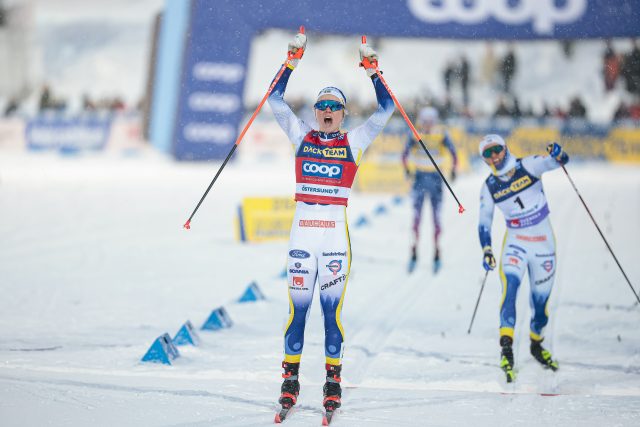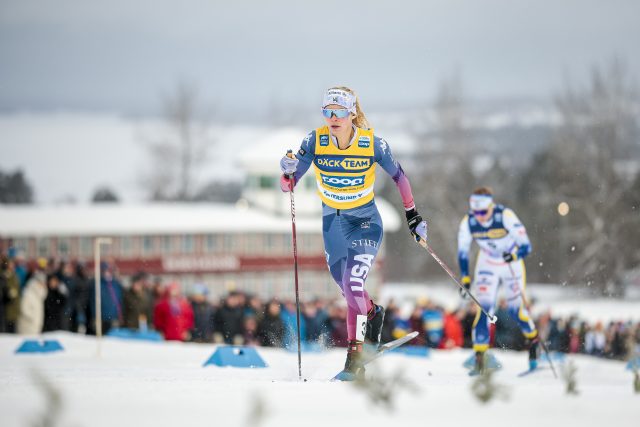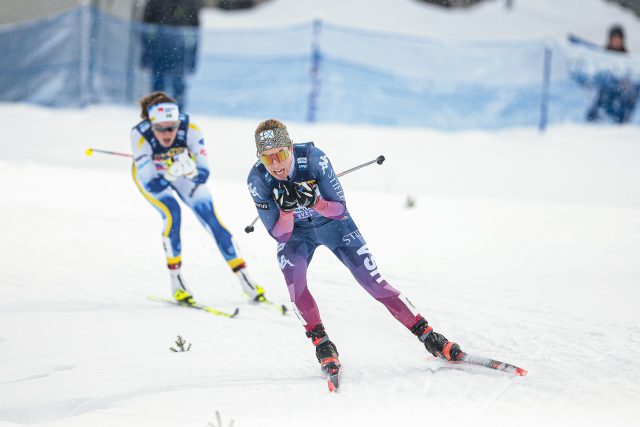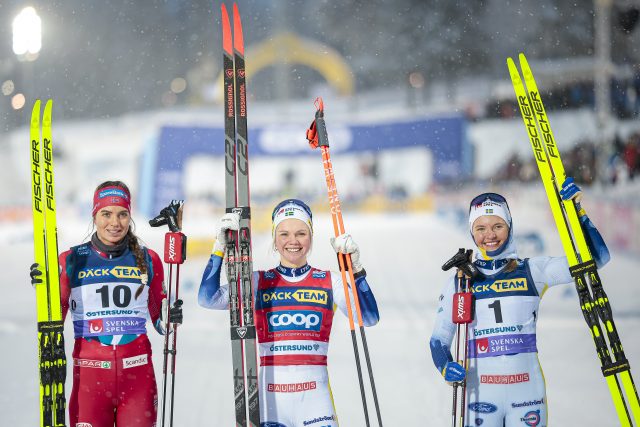 This coverage is made possible through the generous support of Marty and Kathy Hall and A Hall Mark of Excellence Award. To learn more about A Hall Mark of Excellence Award, or to learn how you can support FasterSkier’s coverage, please contact info@fasterskier.com.
This coverage is made possible through the generous support of Marty and Kathy Hall and A Hall Mark of Excellence Award. To learn more about A Hall Mark of Excellence Award, or to learn how you can support FasterSkier’s coverage, please contact info@fasterskier.com.

While much of North America continues to wait for skiable snow, Europe and Scandinavia are enjoying prime, early-winter conditions. Oestersund, Sweden had excellent conditions on its World Cup sprint track, though freshly falling snow seemed likely to affect glide in the tracks throughout the day’s racing. Sweden and the USA continue to dominate recent results, and the sprint in Oestersund proved no exception. Emma Ribom (SW) has won both Classic sprints this World Cup season, while Linn Svahn (SWE)—former World Cup Sprint Crystal Globe winner (2020)—seems to be returning to form as she topped all qualifiers on the day.
Ultimately, Sweden’s Ribom continued her early-season sprint dominance as she skied away from the field to take the win. In second, Kristine Stavaas Skistad (NOR) sprinted past a resurgent Svahn who returned to the podium in third after two seasons struggling with injury.
Starting the day second in the World Cup overall standings, American Rosie Brennan raced to fourth, ahead of World Cup overall leader, Jessie Diggins (USA), in fifth. Julia Kern qualified 15th, but did not advance beyond the quarterfinals. She would finish the day 17th. Other Americans included Alayna Sonnesyn 43rd, and Lauren Jortberg 47th.
“I’m generally pretty excited about my race today,” Brennan said. “I’m pretty sure that was my best ever Classic Sprint.”
Canadian finishers included Katherine Stewart-Jones 34th, and Amelia Wells 46th,
Women’s Classic Sprint
Oestersund’s sprint course is a bit longer than most, and freshly fallen snow filling the tracks would slow things down (especially in the early rounds), making this sprint something of an endurance event. The final downhill is often an area where drafting can influence who crosses the line first, but the new snow seemed likely to minimize that effect.
“This was kind of a distance sprint,” Diggins explained. “It was 3:30, 3:40 for the women. [That’s] a longer sprint which, personally, I like! I think it’s safe to say that [Rosie and I] were pleased with having more time to play around with out there.”
Svahn (SWE) qualified first, returning to the form that saw her win multiple World Cup sprints in years past. Jessie Diggins qualified 3rd , three seconds behind top qualifier, Svahn. Rosie Brennan qualified 6th , only a fraction behind Diggins. Kern qualified 15th, 8.9 seconds behind the leader. Then the snow began to fall, filling tracks and slowing skis. It was a beautiful winter setting for a beautiful winer sport, but competitors may have preferred something a little less scenic and a little more speedy. Wax technicians scrambled to concoct the best combination of kick and glide, while working under the time constraints of the new FIS rules that force teams to deliver skis for fluoro testing far earlier than in the past (and with no opportunity to alter ski bases—or trade out skis—after inspection concludes). It’s a technological and weather-predicting gamble that saw mixed results—some notable slipping, some extraordinary gliding—among the early heats.
In Quarterfinal 1, Ribom (the World Cup Sprint leader) drove the pace to finish just ahead of Skistad. Swedish teammates, Svahn and Frida Karlsson, advanced out of Quarterfinal 2.
Quarterfinal 3 saw Brennan start slowly, but she popped to the front as soon as the course turned uphill. She powered up the slope, hoping her skis would prove fast enough on the subsequent downhill. By the halfway mark, Brennan had pulled clear of the field with only Moa Lundgren (SWE) for company. Brennan cruised to the heat win, only easing up in the final few meters. She was followed across the line by Lundgren.
“It was snowing during the race, and filling in the tracks a little bit . . . My strength is in climbing; the climbing was at the beginning—and it was a little turny coming back to the stadium—so I thought I would just do my best to stay in the front.”
Kern seemed clogged near the back of Quarterfinal 4, while the distance skiers—Lotta Udnes Weng (NOR), Kertu Niskanen (FIN) and Ebba Anderson (SWE)—used their long-fitness to push the pace. Kern’s good skis allowed her to move forward in the final meters, but only enough to finish fourth where her time as not fast enough to earn a lucky loser spot.

Quarterfinal 5 saw Diggins power to a heat victory in the fastest time of the day. The Swedes seemed to have gone light on kick wax: forced to herringbone on the uphills, but hoping to have better glide in the snowy downhill tracks. Diggins apparently realized that strategy; she countered by driving the pace on the uphills, distancing the field early in the course and continuing across the finish line unchallenged. Behind her, Dahlqvist executed a mad-dash double-pole to the finish to pip Finland’s Tiia Olkkonen for second.
Semifinals
The Oestersund snow had stopped falling by the beginning of the semifinals, and the tracks had begun to be skied-in: higher speeds on the downhills, more opportunity for drafting on the downhill leading into the finish. Semifinal 1 was stacked: Svahn, Ribom, Brennan, Karlsson, Skistad appeared poised to follow a fast pace; then no one wanted to take the lead. Brennan pressed the pace on the first uphill, and then the action began. The three Swedes followed Brennan while Skistad dangled unexpectedly off the back. Showing the strength she’s demonstrated in allWorld Cup stops thus far this season, Ribom pulled away for the win, while the fast skis of Skistad allowed he to double pole through top qualifier, Svahn, to grab an automatic entry into the final. Svahn finished third well ahead of Brennan in fourth, and Karlsson in fifth. Svahn and Brennan would would ultimately advance as luck losers.
Semifinal 2 saw Diggins lining up against Dahlqvist, Lotta Udnes Weng (NOR), Moa Lundgren (SWE), and Niskanen. Dahlqvist dropped off the back on the very first uphill (though she did not seem to be suffering from inadequate kick) while Diggins moved to the front with Lundgren. The gap continued to increase as the field entered the two significant downhills. Diggins’s style is not to let up—even when she has a comfortable lead—and she double-poled powerfully across the line for the semifinal win. Dahlqvist sprinted forward from waaaay back to finish a close third (behind Lundgren), though her finishing time was not fast enough to claim a lucky loser spot in the final.
Sprint Final
The snow had begun falling again as three Swedes—Ribom, Svahn, Lundgren—lined up in the final in front of the hometown Oestersund crowd. With them at the line were the two Americans—Brennan and Diggins—and the lone Norwegian, Skistad. Skistad and the Swedes made the pace right from the gun with the Americans trailing, though the pace leveled off quickly allowing Diggins to ease forward on the first uphill. Svahn and Ribom seemed to be slipping a bit on the climb, while Diggins skis appeared solid. Brennan was pinched on a tight corner and was forced to work to regain contact.
“For me, the strategy was just to get to the final by going hard,” Diggins said. “Making sure that it spaced out and didn’t become a race of rushing or people trying to out-corner other people . . . that’s not one of my strengths. So I just decided to go for it and give myself a little space . . . It was a bold strategy, but I was happy with how it panned out . . . I just kind of ran out of gas in the final!”

Once over the climb, the speed of the Swedes’ skis became apparent. While Ribom and Svahn opened a gap, the Americans were forced to work hard to remain in contention. Entering the final righthand turn, Brennan may have been inadvertently interfered with by a Swedish coach; she calmly brushed him aside, managing to push herself forward.
“I was really bummed to be impeded by the Swedish coach,” Brennan said. “That’s really not the first time that’s happened to me; It’s the first time that it was on camera,” She chuckled. “So it’s nice that other people saw it! It’s impossible to know what impact that had on my race; I was obviously gaining momentum and had picked that line because I felt like I could pass some people. I feel like coaches are the people who should know the best about how a race works: in a sprint, all people are fighting for all positions, and all lanes are likely going to be used. [Coaches] should be looking out for more than just your own nation. When I left, the jury was discussing and figuring out what to do. I have no idea what the result of that was, but I’m sure that I’ll find out at some point.”
Ahead of the fray, Ribom showed her class as she glided to the win. All Brennan’s hard work and clever maneuvering was undone by the superfast skis of Skistad who glided through Brennan and powered toward the finish where she caught Svahn for second. Sweden first and third, Norway second, USA fourth and fifth.
Diggins maintains her lead in the World Cup overall race, just one point ahead of Ribom. Brennan remains in the top three as the World Cup returns to Oestersund on Sunday for an Individual Start 10 k Freestyle.
“I am feeling good, and I’m excited to have some sprint in me. That makes me really happy and optimistic . . . things are good right now!”
Women’s Classic Sprint RESULTS

John Teaford
John Teaford—the Managing Editor of FasterSkier — has been the coach of Olympians, World Champions, and World Record Holders in six sports: Nordic skiing, speedskating, road cycling, track cycling, mountain biking, triathlon. In his long career as a writer/filmmaker, he spent many seasons as Director of Warren Miller’s annual feature film, and Producer of adventure documentary films for Discovery, ESPN, Disney, National Geographic, and NBC Sports.



